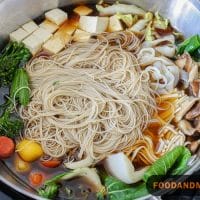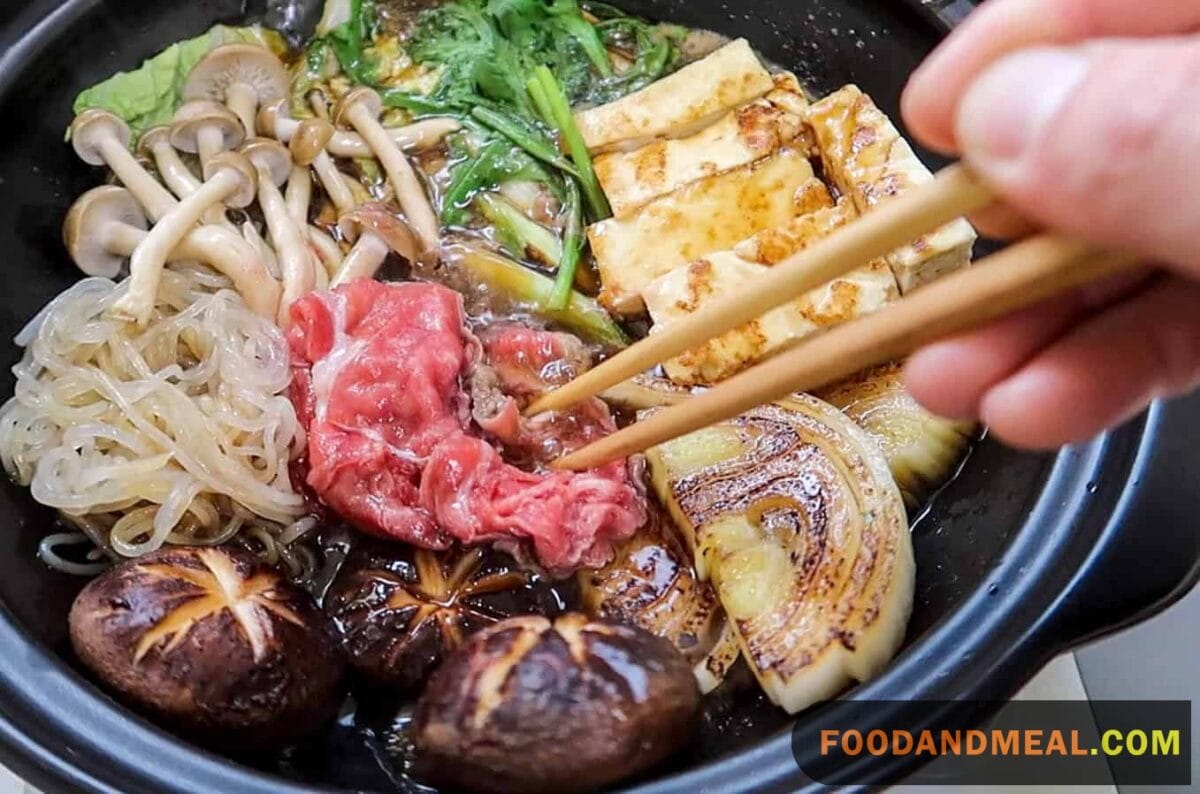As the weather turns crisp and the leaves start to fall, I find myself craving the rich, comforting flavors of classic Japanese sukiyaki. But as a vegetarian, I often struggle to find a meatless version that truly captures the sweet and savory essence of this iconic hot pot dish. That’s why I’m so excited to share my recipe for Japanese Vegetarian Sukiyaki – it’s packed with umami-rich ingredients like enoki mushrooms, soft tofu, sweet white negi onions, and clear konbu dashi broth.
My passion for this vegetarian twist comes from fond memories cooking sukiyaki with my grandmother as a child. I loved crowding around the table as ingredients simmered away, filling the kitchen with the most wonderful savory aromas. Now that I follow a vegetarian lifestyle, I try my best to recreate the nostalgic flavors and experience of my grandmother’s sukiyaki – but without the meat. Each sweet-tangy bite of tofu and mushroom transports me right back to her warm, bustling kitchen.
I hope this soulful, plant-based version inspires you to gather friends and family to bond over a steaming, bubbling pot filled with the comforting flavors of Japan. Let’s keep traditions alive while enjoying meatless meals! Now who’s ready for some soothing, veggie-packed sukiyaki?
Japanese Vegetarian Sukiyaki Recipe

Japanese Vegetarian Sukiyaki
Equipment

Ingredients
- 4 cups of water, filtered
- 3⁄4 cup of tamari sauce
- 3⁄4 cup of cooking wine, rice (mirin)
- 1⁄2 cup of sake
- 3 tablespoons of sugar, palm or white
- 8 oz. of noodles, your favorite – cellophane, shirataki, udon, etc.
- 1 cup of Bok choy, chopped
- 2 cups of Napa cabbage, chopped
- 1 cup of stemmed, sliced mushrooms, shiitake
- 1 cup of broccoli, Asian
- 1 cup of carrots, sliced
- 1 cup of 4” cut green onions
- 1 x 14-oz. pkg. of tofu, extra firm
- A bit of oil or veggie broth for sautéing the vegetables
Instructions
- Rinse, then soak noodles in hot, filtered water if they need softening. Udon and cellophane especially need soaking in water for softening. Drain well.
- Wash, then chop tofu and vegetables.
- In large sized pot, sauté mushrooms and green onions with a bit of vegetable broth or oil till browned slightly. Remove. Set aside.
- Add filtered water, mirin, tamari, sugar and sake to pot. Simmer till sugar dissolves. Add carrots and broccoli. Simmer for several minutes. Add cabbage and Bok choy.
- Simmer for several minutes. Reduce heat to low. Add noodles, tofu, green onions and mushrooms. Allow to warm for several additional minutes, till all ingredients have cooked. Turn heat off. Serve in small bowls with dipping sauce.
Video
Notes
- Customize with Vegetables: Remember, Vegetarian Sukiyaki is versatile. Feel free to toss in your favorite seasonal veggies for a personalized touch. Love the recipe? Share your version using #MySukiyakiTwist and subscribe for more unique dishes!
- Broth Depth: For a deeper flavor, let the broth simmer a bit longer. The longer it cooks, the richer the taste. Impressed by the depth of flavors? Share the recipe and join our community for more secrets by subscribing!
- Noodle Choices: Traditionally, sukiyaki pairs well with glass noodles. However, udon or ramen can add a delightful twist. Experimented with the noodles? Share your creation, and don’t forget to subscribe for more innovative tweaks to traditional dishes!
Nutrition
© Food And Meal
This website provides approximate nutrition information for convenience and as a courtesy only. Nutrition data is gathered primarily from the Spoonacular Database, whenever available, or otherwise other online calculators.
Vegetarian Sukiyaki in a Slow Cooker
Begin by preparing vegetables uniformly for even cooking. Sear tofu cubes to enhance texture and prevent breakage. In the slow cooker, layer seared tofu at the bottom, followed by a strategic arrangement of vegetables. Meanwhile, prepare Sukiyaki broth separately and pour it gently over the contents in the slow cooker. Cook on ‘Low’ for 4-6 hours, ensuring vegetables maintain their texture. An hour before serving, introduce glass noodles to absorb flavors. Serve directly from the slow cooker, pairing with rice or relishing it as a standalone dish.
Cooking Tips for the Perfect Vegetarian Sukiyaki

When making my Japanese Vegetarian Sukiyaki, I always start by preparing a light but flavorful konbu dashi broth seasoned with mirin, soy sauce, and ginger. This provides the perfect savory base for the vegetables to soak up. I like to use a mix of meaty king oyster and shiitake mushrooms, sweet onions, soft tofu, and crisp negi scallions for contrasting textures.
My favorite part is when everything comes together in the hot pot – the sweet aroma fills the whole house! I carefully dip the tender mushrooms and tofu into the lightly beaten raw eggs, allowing them to coat gently without overcooking. The eggs impart such a lovely creaminess. And mixing the bright ponzu sauce into the broth creates the most crave-worthy sweet and tangy flavor.
As friends and family gather around, laughing and cooking ingredients in the bubbling pot, I’m filled with nostalgia for my grandmother’s kitchen. These vegetarian tweaks allow me to keep tradition alive while accommodating my lifestyle. With each comforting, soulful bite, I’m transported right back to the warmth of her bustling stove.
Serving Suggestions for Vegetarian Sukiyaki

s you immerse yourself in the comforting warmth of the Clear Onion Soup, there’s a sense of tranquility that envelops your taste buds. The savory delight of Vegetarian Gyoza adds a touch of familiarity, like a warm embrace from an old friend.
Tofu Kimchi Soup brings a harmonious blend of spicy and umami, perfectly complementing the rich depth of the Sukiyaki. The intricate textures of Norimaki Mochi and the umami-packed Vegetable Maki transport you to a place of culinary bliss, reminiscent of the joy of discovering hidden gems in a bustling Japanese marketplace.
Wakame Miso Ramen, with its soul-nourishing broth, elicits a feeling of comfort akin to a cozy rainy day spent indoors. Meanwhile, the playful and delightful notes of Egg Muffin Cups bring a sense of joy, reminiscent of weekend brunches with loved ones.
The Teriyaki Salmon, glistening in its succulent glory, paired with the subtle Soy Dipping Sauce, introduces a touch of elegance to the feast. Each dish, meticulously chosen to accompany the Sukiyaki, reflects the nuanced and layered experience that is Japanese cuisine.
FAQs on Vegetarian Sukiyaki

- Can I make Vegetarian Sukiyaki ahead of time? Absolutely! The flavors meld even better when allowed to sit. Just ensure you warm it up well before serving. If it thickens, you can add a bit of broth or water during reheating.
- How do I store leftovers? Cool the Sukiyaki to room temperature, transfer it into an airtight container, and refrigerate. It should be consumed within 2-3 days for the best taste and freshness.
- Can I freeze Vegetarian Sukiyaki? Yes, but it’s advisable to freeze only the broth. Vegetables may lose their texture upon thawing. When ready to enjoy, simply thaw the broth, heat, and add fresh vegetables and tofu.
- What if I can’t find some of the traditional vegetables? The beauty of Sukiyaki is its versatility. Feel free to use any vegetables you have on hand or those that are in season. Just adjust the cooking times accordingly.
- My Sukiyaki tastes too bland. How do I fix it? Sukiyaki’s charm is in its broth. If it’s bland, adjust with a touch more soy sauce, mirin, or sugar. Remember, it’s all about that beautiful balance of sweet and savory.
Conclusion
I hope this recipe for Japanese Vegetarian Sukiyaki transports you to the warmth of my grandmother’s kitchen, filled with the sweet aromas of tender mushrooms and tofu simmering away. Though my meatless version may not be exactly like hers, I do my best to recreate those nostalgic flavors and memories from childhood. I’m so happy to be able to share this comforting, soulful hot pot dish with the Food And Meal community.
If you make this sukiyaki at home, I’d love to see your vegetarian creations! Please share photos on social media and tag @foodandmeal so I can take a peek into your kitchens. And feel free to leave a comment below letting me know what ingredients you added to make this plant-based dish your own. I can’t wait to see the unique spins you put on this Japanese classic.
Hi! I'm Nazia of ‘Nazia Cooks’, a self-taught baker and cook residing in Chennai. Rooted in the rich South Indian culinary landscape, my palate has expanded to embrace global flavors. I revel in crafting fusion dishes, melding traditions to birth unique tastes.

